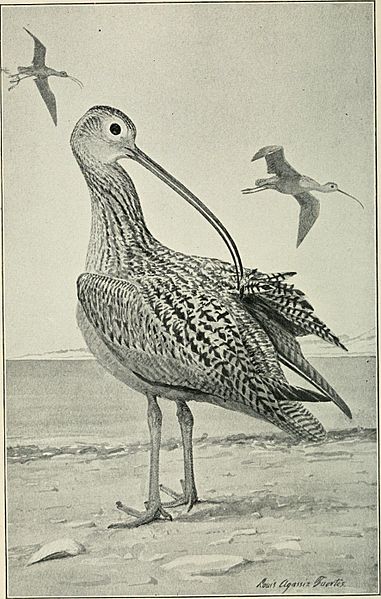Image: Handbook of birds of the western United States, including the great plains, great basin, Pacific slope, and lower Rio Grande valley (1904) (14568956967)

Description: Identifier: handbookofbirds00bail (find matches) Title: Handbook of birds of the western United States, including the great plains, great basin, Pacific slope, and lower Rio Grande valley Year: 1904 (1900s) Authors: Bailey, Florence Merriam, b. 1863 Subjects: Birds -- West (U.S.) Publisher: Boston, New York, Houghton, Mifflin and company Contributing Library: American Museum of Natural History Library Digitizing Sponsor: Biodiversity Heritage Library View Book Page: Book Viewer About This Book: Catalog Entry View All Images: All Images From Book Click here to view book online to see this illustration in context in a browseable online version of this book. Text Appearing Before Image: n wings and back with dusky and buff.Length : 7-8, wing 4.05-4.60, bill .90-1.05, tarsus .90-1.05. Remarks. — In the field the spotted sandpiper can always be recognizedby its small size, plain gray color, and the conspicuous white bar along themiddle of the wing in flight. Distribution. — Whole of North America, breeding throughout most ofits range ; south in winter to Brazil and Uruguay. Nest. — On dry ground in tuft of grass or under low bush, lined withleaves and grass. Eggs: 4, buffy, spotted with lilac, dark brown, andblack. Although never numerous or in flocks, the spotted sandpiper orriver sand peep is the commonest and best known of our sandpipersover the country at large. There is hardly a patch of water fromthe brooks in the mountain meadows to the rivers in the lowlandswhich has not one or more pairs of these little quaker gray birdspicking along their shores with teetering gait, and with shrill peet-weet, buzzing from stone to stone so fast that their wing tips seem Text Appearing After Image: LONG-BILLED CURLEW SNIPES, SANDPIPERS, ETC. 101 always to be pointing down as they fly, their whole bodies tippingviolently when they alight. This teetering motion, which becomesridiculously rapid under excitement or alarm, has given the bird itsfamiliar names of tip-up and teeter-tail. GENUS NUMENIUS. General Characters. — Bill curved and slender, long-er than tarsus ; frontof tarsus with transverse scutellte; toes webbed at base. KEY TO SPECIES. 1. Bill of adult longer than tarsus and middle toe ; crown not striped. longirostris, p. 101.1. Bill not longer than tarsus and middle toe. 2. Crown black with middle line of buff . . . hudsonicus, p. 102. 2. Crown specked, without middle line of buff . . borealis, p. 102. 264. Numenius longirostris Wils. Long-billed Cuklew. IMumage liglit cinnamon, barred and mottled on \ipper parts with duskyand black ; outer webs of outer quills wholly black ; head, neck, throat,and chest streaked with dusky ; crown mainly dusky; belly plain cinna-mon ; Note About Images Please note that these images are extracted from scanned page images that may have been digitally enhanced for readability - coloration and appearance of these illustrations may not perfectly resemble the original work.
Title: Handbook of birds of the western United States, including the great plains, great basin, Pacific slope, and lower Rio Grande valley (1904) (14568956967)
Credit: https://www.flickr.com/photos/internetarchivebookimages/14568956967/ Source book page: https://archive.org/stream/handbookofbirds00bail/handbookofbirds00bail#page/n218/mode/1up
Author: Internet Archive Book Images
Permission: At the time of upload, the image license was automatically confirmed using the Flickr API. For more information see Flickr API detail.
Usage Terms: No known copyright restrictions
License: No restrictions
License Link: https://www.flickr.com/commons/usage/
Attribution Required?: No
Image usage
The following page links to this image:

